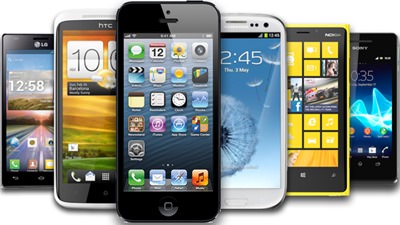 It’s probably too late for new players to get into the e-book reader market, at least if they want to be more than a modest success—almost everybody who would want such a device already owns a Kindle, so the number of people in a position to buy new devices is vanishingly small. (And when people are, they’ll probably want to buy another of what they own now. Which is probably a Kindle.) Might smartphones be reaching the same status?
It’s probably too late for new players to get into the e-book reader market, at least if they want to be more than a modest success—almost everybody who would want such a device already owns a Kindle, so the number of people in a position to buy new devices is vanishingly small. (And when people are, they’ll probably want to buy another of what they own now. Which is probably a Kindle.) Might smartphones be reaching the same status?
Wired quotes an IDC study that shows the amount of worldwide smartphone sales growth is expected to drop below 10% this year. That is to say, only 10% more people will buy new smartphones in 2015 than bought them in 2014. Wired notes that this is the first year overall growth slowed to below 10%. A chart in the report shows Apple as the big beneficiary, with a 17.3% growth rate in iOS phones. Android comes in at 9.5% growth, while Windows Phone shows a 10.2% decline and all other smartphone OSes come in for a 16.8% decline.
Wired credits the slowing growth to market saturation in China, the world’s largest smartphone market. Almost everybody there who had a feature phone and was going to upgrade to a smartphone already has. Now other markets are experiencing growth, notably the Middle East and Africa.
To maintain momentum there, phone manufacturers will have to push low-cost phones that people in those markets can afford. Meanwhile, in more developed parts of the world, they will need to focus their attention on device financing and trade-in options—pretty much exactly the way Apple is doing in the US right now with its iPhone Upgrade program. Of course, even Android phones get trade-in support, but it usually comes from the cellular carrier at this point.
As a latecomer to the market, Windows Phone is in an awkward position. Given that most users have already settled on iPhones and Android devices, there are few new phone buyers to make up a potential market. They’re going to depend on luring people away from other ecosystems, and both iOS and Android have had years to develop and mature their platforms to the point where either one of them can do most of the things anybody needs.
Given that it has considerably fewer users, Windows has had a hard time attracting developers to create applications for the kinds of uses people are going to want to make of their phones—such as e-reading. As David pointed out earlier today, the future looks fairly bleak for Windows Phone.
Given that smartphones and tablets are similar to e-readers in that once one has invested in an platform, there is less incentive to switch away, it may effectively be too late for Windows to lure many people away from more-developed platforms—and without more users, there’s no incentive for developers to make Windows more attractive. Strange as it is to say about the operating system that has effectively conquered the desktop, Windows winds up on the wrong end of the chicken-or-the-egg scenario when it comes to the smartphone. (And the really small platforms, like the Firefox Phone or the Ubuntu phone, may never be more than curiosities.)
This doesn’t bode too well for any other potential newcomers to the market, but at least it means those of us who use iOS or Android can probably look forward to a reasonably secure future for our devices and our operating systems—including access to more e-reading applications.

































There’s a heck of a lot of lock-in with cell phones and tablets. Although I don’t have most installed and only picked them up because they were marked down or free, I have over 600 apps for my iPhone and iPad. There’s not much I don’t have an app for.
It’d take a lot to get me to abandon all that and shift to Android, much less a Kindle. Contrast that to Adobe’s Creative Cloud, where I could shift from iOS/OS X to Android/Windows in about a day and without spending a penny. Even my documents (books) will open on either platform.
Apple’s biggest problem may be that these extremely low-priced tablets and smartphones will mean that a lot of people, particularly teens and students, will opt for Android. Then that lock-in would work against Apple. Were I Tim Cook et al, I’d encourage a healthy used market for iPhones that get turned in under Apple’s own in-house upgrade plan:
http://www.apple.com/shop/iphone/iphone-upgrade-program
Offer those last-year iPhones to established refurb resellers like A4C. Those who buy refurb will later buy new.
Amazon, Apple and other tablet makers are in that game for refurb tablets. Expand that into smartphones. App lock-in is very powerful. Offering a refurb-to-new pathway for smartphone customers would be good for business in the long run.
Apple also needs to port its iBooks app to Android and Windows.
The slowing growth matters less than the fact that Samsung and Apple make 105% of the profit in this market. There’s no money in it for entrants, not unless they use a model other than retail sales.